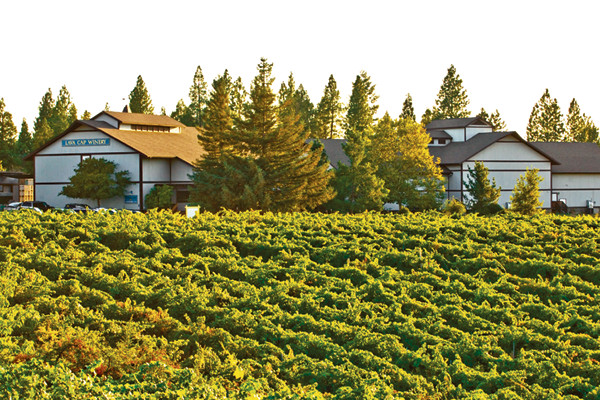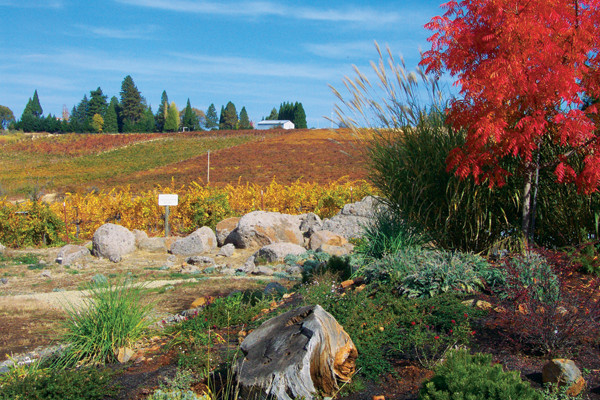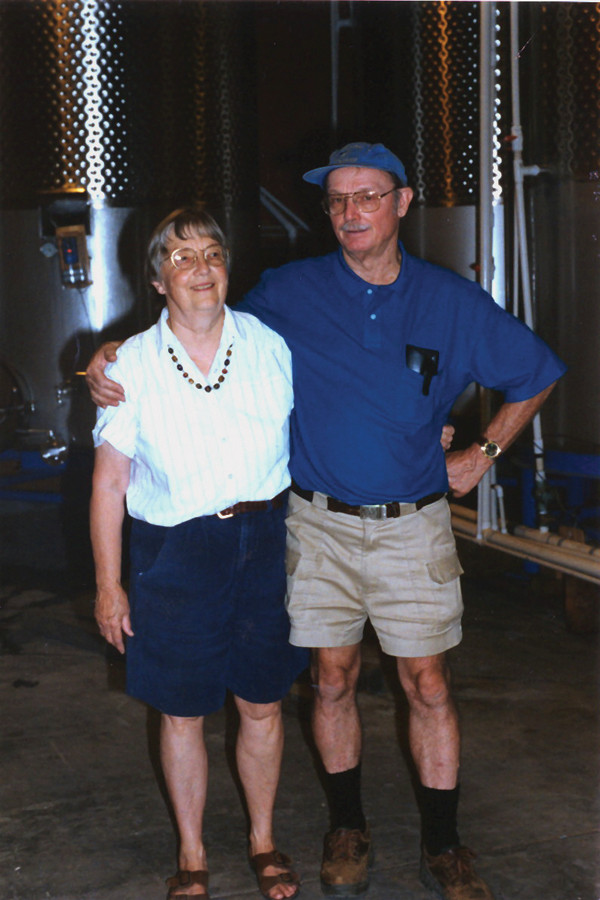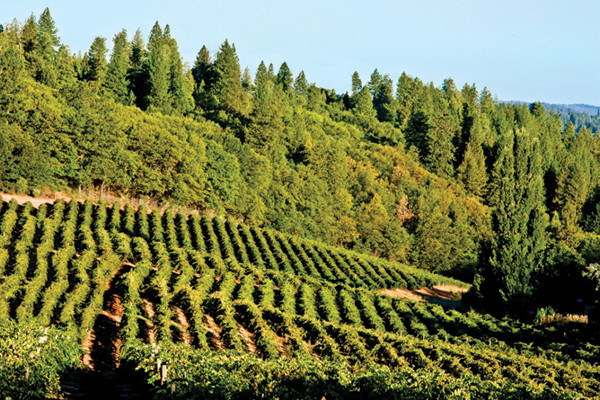
by Terri Cook Monday, April 15, 2013

Lava Cap Winery lies in the foothills of the Sierra Nevadas near the site of California's first Gold Rush strike. courtesy of Lava Cap Winery

Volcanic mudflow deposits of the Miocene-aged Mehrten Formation crop out in the vineyard. courtesy of Lava Cap Winery

Geologist David Jones started Lava Cap Winery with his wife Jeanne in the 1980s. courtesy of Lava Cap Winery

Thanks to its location and rich volcanic soils, Lava Cap Winery is able to make 12 different wines, but is best known for its zinfandel. courtesy of Lava Cap Winery
During a long career at the U.S. Geological Survey (USGS) and the University of California at Berkeley, paleontologist David Jones, who died in 2007, made fundamental contributions to understanding the geologic history of western North America, particularly the evolution of California’s puzzling Coast Ranges. One of Jones’ more significant contributions was a paper on the distribution of Buchia, a Mesozoic mollusk, which provided critical age information and helped clarify very complex structural relations in the Coast Ranges. “But Davy was much more than a paleontologist,” says colleague Eli Silver, a geophysicist at the University of California at Santa Cruz who studies continental margin evolution. “He was an outstanding stratigrapher and structural geologist, and a field geologist second to none. He really knew geology inside and out.”
Over the years, Jones and his colleagues came to understand that fragments of Earth’s crust that formed as part of — and later broke from — one tectonic plate could eventually get plastered onto a different plate, preserving the fragment’s own unique history in the process. According to Berkeley colleagues Walter Alvarez and Mark Richards, Jones’ work defining these so-called terranes played a “central role in the evolution of the simple theory of plate tectonics into a more complex and subtle theory capable of explaining the geological details actually observed in the field.” For his contributions to geology, Jones was honored with the National Academy of Sciences’ prestigious Mary Clark Thompson Medal in 1995.
In addition to geology, though, Jones had another passion, one that developed into a successful family business that his wife and sons carry on today — winemaking.
After earning his Ph.D. from Stanford, Jones went to work for the USGS in Menlo Park where he became an active member of an informal group of employees who shared an interest in home winemaking. He was soon tending about 50 vines in his backyard in Los Altos Hills — but his aspirations quickly grew.
While still in Menlo Park, Jones and his wife Jeanne — his sixth-grade sweetheart — began searching for property on which to start a vineyard. They finally discovered a 26-hectare former pear farm in the foothills of California’s Sierra Nevada Mountains. Located in Placerville, near where gold was discovered in 1848, the farm “had good water, a mild climate, gentle topography, good volcanic soil, and it even afforded marketing potential for our wine,” Jeanne says. “So we took the plunge and bought it.”
They named the winery Lava Cap, after the miners’ term for the resistant, Miocene-aged volcanic rock that caps the foothills’ famous gold-bearing gravels. According to Silver, during the Miocene eruptions, lava flowed down existing canyons, burying them in the process. As the Sierra Nevada Mountains were uplifted, erosion ate away the adjacent softer rocks, leaving the andesitic and basaltic lavas exposed as highs between them. During the Gold Rush, miners would search for the volcanics to locate the gravels — and, they hoped, the gold. Andesite that is part of the Mehrten Formation can be found on the upper section of the Lava Cap estate, which still bears artifacts and scars left behind by the miners.
The winery’s location in the foothills exposes the vines to cool evening breezes that keep the grapes small, concentrating their flavor and helping produce wines that have received hundreds of awards over the past 27 years. The higher elevations also produce lower daytime temperatures, which are conducive to growing Bordeaux varietals like cabernet sauvignon, merlot and cabernet franc. Although Lava Cap’s biggest seller is chardonnay, according to “The Wine Bible” by Karen MacNeil, the region’s reputation “rests solidly on its reds,” and Lava Cap’s zinfandel is “one of the best in a crowded field of terrific foothill zins.”
The foothills wine industry began shortly after immigrants, particularly Italians, brought vines with them when they arrived following the gold strikes. According to MacNeil, by the 1860s the gold counties were home to almost 200,000 vines. However, declining populations in the decades that followed, accompanied by the double whammy of an infestation of the root louse Phylloxera and the adoption of Prohibition, decimated the industry. A half century passed before small family vineyards once again began to take root in the region. Today, 40 mostly family-run wineries have planted more than 1,400 hectares of vines.
When the Jones family planted their first vines in 1981, the county government was promoting the region as a grape-producing area and assisting new growers. Commercial nurseries provided the vines, which the University of California at Davis had certified as disease-free. Still, it was tough going at first. The jump from home winemaking to commercial-scale production was challenging. “We just started,” Jeanne says. “We didn’t know exactly where it was going to go, to tell the truth. We just dove in and kept going.” It was five years before Lava Cap produced its first bottles.
Soon, both the Jones sons — Charlie and Tom — joined the team. “Without the boys coming and helping us, we would never have progressed in the way we have,” Jeanne says. “They are a very important part of our success.” Today, Charlie is the vineyard manager and Tom is the winemaker. Like their father, both have degrees in geology.
Lava Cap grows grapes in two types of soil. The first is the soil derived from the 5-million to 11-million-year-old volcanic Mehrten Formation, which is located near the top of the property, where white and several of the red varietals, including grenache, zinfandel and syrah grow. The Mehrten Formation “makes an incredibly wonderful soil,” Tom says. “Really nice drainage and texture, with beautiful richness, but it’s shallow enough that you can limit the water and thus keep the leaf canopy under control. This allows sunlight onto the grape clusters, promoting intense flavors and full wine structure.” At lower elevations on the property, a granitic pluton crops out, forming a very different soil, on which petite sirah and cabernet franc grapes grow.
“David always said this area is one of the few places in the world that can grow as many different kinds of grapes as we do here,” Jeanne says. “We have 12 different kinds of wine, and it’s due to the varied topography, the high elevation, and the many resulting microclimates. That’s one of the things that all the people who grow grapes here have to study and work out because you can’t paint with a broad brush.”
In winemaking, the expression of the local environment in the wine is called terroir. But just how the soil translates into different types and flavors of wine isn’t exactly known. “That’s the million-dollar question,” says Tom, who also received a master’s degree in viticulture and enology from the University of California at Davis. “It’s really hard to pin down anything because there are so many variables, even in just the fermentation process. It’s really difficult to extrapolate results back to causations. To do it scientifically, you have to control all the variables except that one, and it’s almost impossible.”
Lava Cap’s largest wholesale market is Sacramento, and approximately half of the winery’s sales come through Lava Cap’s popular tasting room. The company distributes wine to 26 states, and geologists are a valued part of their clientele. “I think geologists tend to have an affinity for all earth-related endeavors,” Tom says. “We get our fair share of geologists coming through, including my father’s old friends from the Survey and Berkeley, who like to reminisce.” Eli Silver agrees. He first savored a bottle of Lava Cap fume blanc at a restaurant in Mammoth, Calif., and was so impressed that he became a member of Lava Cap’s wine club.
According to wine expert MacNeil, the wineries in the Sierra foothills are not as well known as they deserve to be, given “the quality and distinct personality of the best wines,” although she believes this is changing as Lava Cap and its neighbors begin to develop national followings. Building that growing market may be the task for the next generation of Joneses. Charlie and Tom each have a son currently taking college-level geology courses, although according to Jeanne, it’s too soon to tell if they’ll follow in their grandfather’s and fathers' footsteps, either by pursuing geology or winemaking — or both.
© 2008-2021. All rights reserved. Any copying, redistribution or retransmission of any of the contents of this service without the expressed written permission of the American Geosciences Institute is expressly prohibited. Click here for all copyright requests.